Wheelchair Helper
An add-on to improvement of a standard wheelchair. The main structure includes: a basket, a placeholder for hands and a machine that controls the basket up and down. The purpose of this add-on is to make a standard wheelchair work and feel like the new generations of wheelchair. A basket add-on, a new handle refresh, and it goes up when the user presses a button on the remote in order for easy access. It’s cheap and easy to install, and it's the best option for handicapped people who don't want to spend much money on a new wheelchair.
Background
I was inspired by studying Professor Hawking’s talking machine which is the pioneer of AI, and I tried to combine my interest in engineering and healthcare to design a new assistive device that helps patients regain mobility at home.
When I joined the NCSU engineering program in July 2020, I designed a futuristic wheelchair add-on by Fusion 360 aiming to provide good mobility for the disabilities. I made a prototype by Legos, then realized the front end of my wheelchair was too heavy as I installed a basket. I tried by adding two more wheels underneath while adjusting the basket closer to the middle.
I eventually came up with a new design of the “Wheelchair Helper” as shown below. My design concept is still in progress and will be constantly improved in the future.
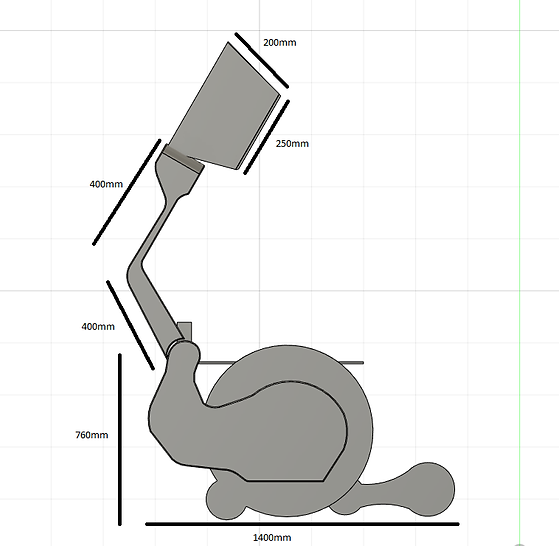
The Problems that Wheelchair Users Face (Per Survey from Karman Healthcare)
Able-bodied people find it difficult seeing line through the wheelchair user. Wheelchair users often feel talked down to or even ignored. People wrongfully think that the wheelchair user should be more independent. Some daily problems that wheelchair users encounter include:
1.
Dirty hands as a result of pushing themselves in a manual wheelchair
2.
Mirrors are not usually at their height
3.
Public transits aren’t usually set up for disabled people
4.
Buses can be especially challenging when they have to wait to see if the wheelchair ramp really works
5.
Should they give up space on the bus for a stroller?
6.
Dealing with people who abuse wheelchair parking spaces
7.
The dirty looks you get when you drive into a handicap parking spot
8.
The look people give you for doing the most mundane things like getting gas
9.
Having to let other people know you are OK constantly
10.
Answering ridiculous questions like “Do you have a job?”
The Problems that Wheelchair Users Face
(Per Survey Conducted by Myself Wheelchair Survey)
To improve my design of the “Wheelchair Helper”, I conducted a survey aiming to identify the general public’s knowledge of wheelchairs as well as potential challenges experienced by the wheelchair users while grocery shopping. This survey was conducted among 78 people. 59.3% of the responders are family or caregivers of wheelchair users, 5.1% are medical personnel whereas only less than 35.6% are wheelchair users. Here is the summary of my key findings:
1. Most people have only moderate understanding of wheelchair structures and wheelchair features.

2. The results suggested there was a weak positive correlation (r=0.36) between understanding of wheelchairs, and heard about wheelchair add-ons. This means that people with knowledge of wheelchairs are more likely to know about wheelchair add-ons.

3. Safety is the main consideration for choosing a wheelchair (41.7%), followed by features (20.2%), then price (19.0%) and size and shape(19.0%).

4. More than 40% of responders have heard of wheelchair add-ons, and nearly 75% will consider purchasing such add-ons to improve quality of life.
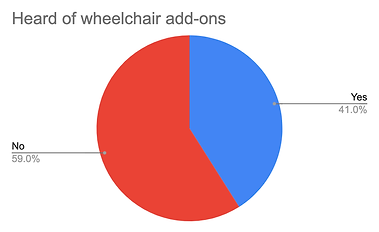.png)
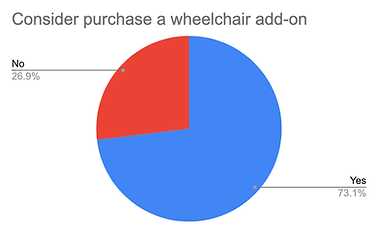.png)
5. Height adjustable seat is the more desirable add-on, followed by basket and collision sensor
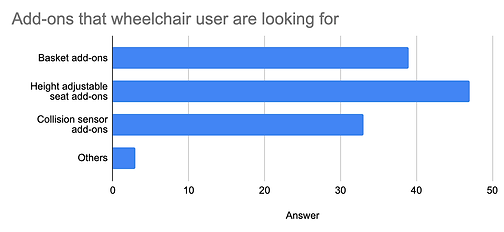.png)
Design Philosophy based on above Survey Results
People often don’t realize just how difficult it can be for individuals in manual wheelchairs to complete a regular daily task like grocery shopping. Grocery stores offer plastic hand baskets. Unfortunately, those plastic hand baskets could be unstable and uncomfortable to use. Some grocery stores offer motorized shopping carts.
However, those motorized shopping carts require the wheelchair users to leave their own wheelchair, leaving the expensive and personal wheelchairs unattended while they shop. The goal of this project was to develop a basket add-on (“Wheelchair Helper”) to improve a standard wheelchair.
This Wheelchair Helper is an easily attachable shopping aid that provides a stable location for groceries. The shopping aid resembles a hand-held shopping basket that is stably fixed to the front of the wheelchair. The Wheelchair Helper can be quickly installed along with the wheelchair’s frame, which gives the shopper easy access to groceries and allows them to use their own wheelchairs.

Initial Design Manuscript

Design Principle
The Wheelchair Helper will come with a basket, pair of arms, pair of wheel holders, and two motors that are usually placed behind the chair back. The first motor will control the arms to make the helper to switch from different modes (open or close). The second motor, connected by the remote on the arms, will control the wheels on the standard wheelchair. There will also be sensors around the wheel holder that will sense the surroundings and assist the wheelchair to determine the direction, to avoid hitting any objects.

Wheelchair Helper v1
The first version of the Wheelchair Helper was designed during the NC State engineering camp, everything looks and works fine, but there is one big defect, it will constantly fall due to not being balanced.
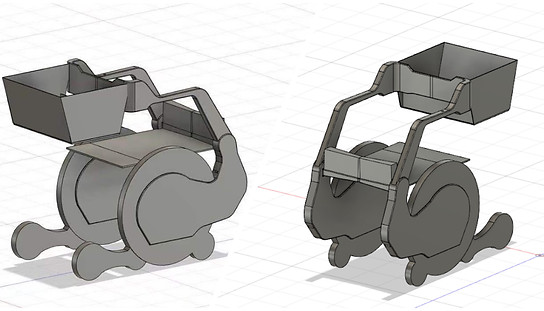
Wheelchair Helper v2
The second version added two front wheels and also adjusted the basket closer to the user in order to make the wheelchair more balanced and the basket to be more reachable.
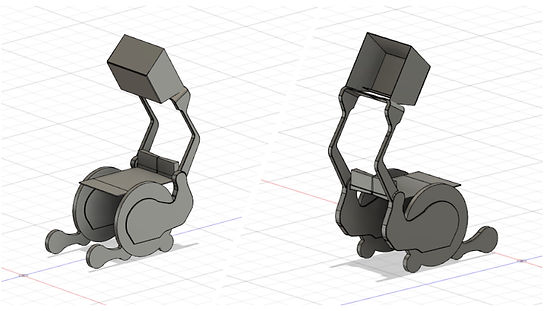
Wheelchair Helper v3
The third version added a modification that will raise up the basket by pressing the remote. The user will be using this function whenever they want to access in and out.
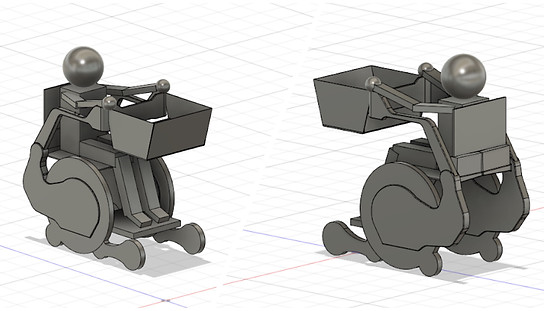
Wheelchair Helper v4
The fourth version added a human model on the wheelchair model for better future measurement predictions.
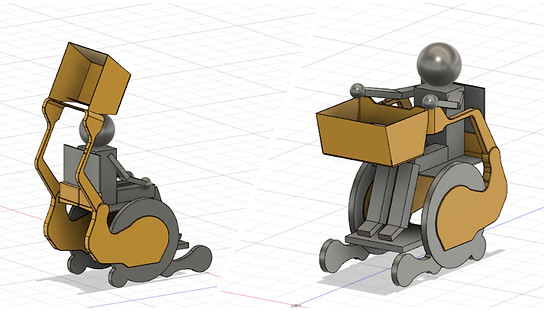
Wheelchair Helper v5
The fifth version added colors on the main product (wheelchair add-on) to eliminate the possibility of confusion on the product.
Desired Impact to the Potential Users
The Wheelchair Helper will enable the individuals in manual wheelchairs to shop freely and ergonomically. Since the potential wheelchair users are expected to be active and independent individuals, this Wheelchair Helper will give those users a shopping method that allows them the same level of independence they have when completing other common tasks.
I hope my design will allow the individuals in manual wheelchairs to shop much more efficiently, quickly and with less frustration than the typical shopping experience of a wheelchair user. Hopefully this will provide a step toward their greater independence.
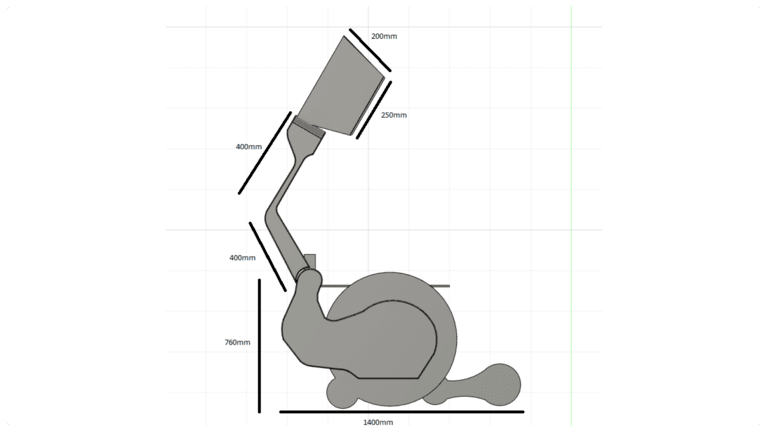
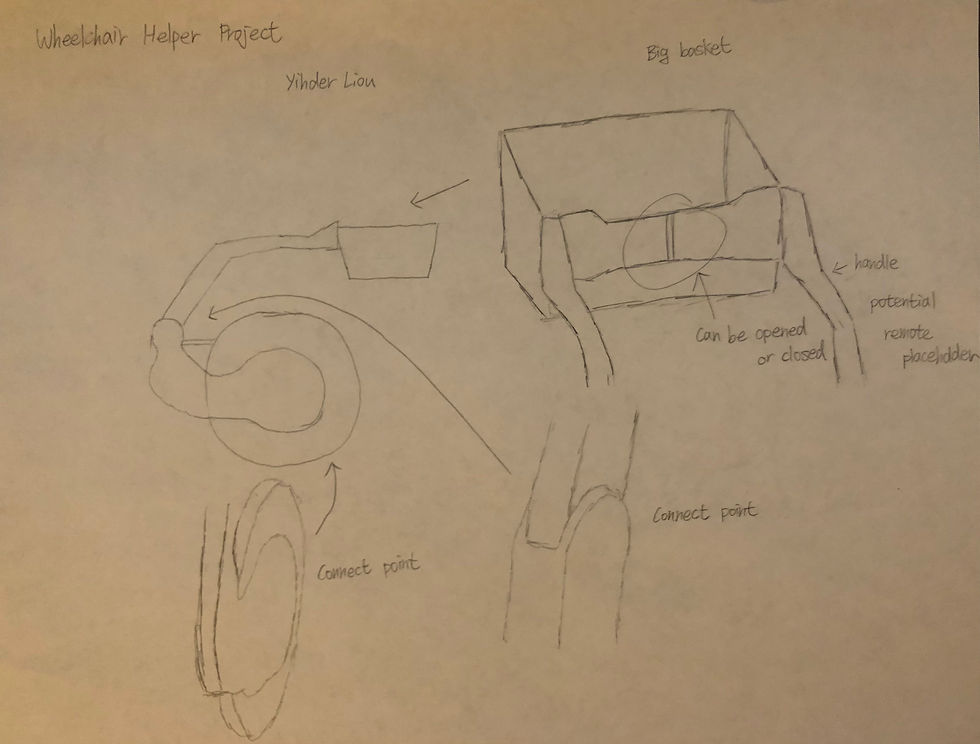
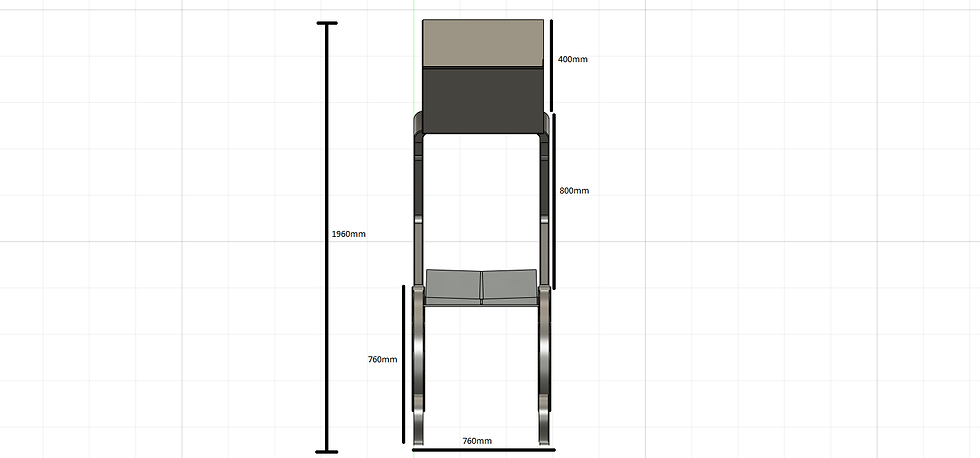

Future Improvement
People with disabilities greatly suffer because of the many physical and social barriers they face.
The digital age and the Internet of Things (IoT) technologies is starting to break down some of these barriers. For example, wheelchair users may not be able to reach items placed beyond their arm’s length, limiting their independence in everyday activities like shopping, or visiting libraries. Some examples of IoT are systems which enable wheelchair users to interact with items placed beyond their arm’s length, with the help of Augmented Reality (AR) and Radio Frequency Identification (RFID) technologies.
With the advanced inventory provided by the RFID system, an interactive AR application runs on different interfaces which allows the users to digitally interact with the physical items on the shelf. The resulting experience will be close to being able to browse a shelf, clicking on it and obtaining information about the items it contains, allowing wheelchair users to shop independently, and providing autonomy in their daily activities.
My hope is that the IoT technology will be applied in my Wheelchair Helper to assist in overcoming a larger portion of challenges faced by wheelchair users, resulting in their improved autonomy and equal opportunity and access!